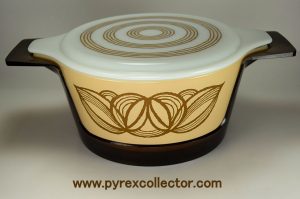
1973 Raffia 475 promo with hugger cradle. I've had the lid and cradle for some time, but, packed only in loose styro peanuts, the dish didn't survive shipping with them. Finally found another dish at a decent price to complete the set.

Information for the Vintage Glass Kitchenware Enthusiast

1973 Raffia 475 promo with hugger cradle. I've had the lid and cradle for some time, but, packed only in loose styro peanuts, the dish didn't survive shipping with them. Finally found another dish at a decent price to complete the set.
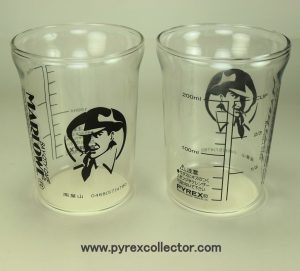
Pyrex pudding cups from the Marlow Bay-City Cafe in the Japanese town of Hayama. There are several versions of the cup, some with the graduations, others with only a top fill line, and those with and without the website URL and the legend "Since 1984". Customers can opt to keep the cup as a souvenir or return it for a deposit of ¥200 (about $2). The pudding is like an egg custard or flan, and supposedly very good.
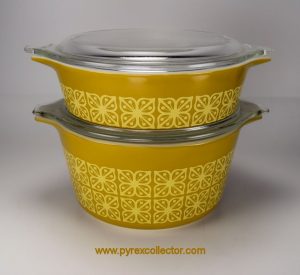
Autumn Floral, 1966. 470 series Cinderella round casseroles only. Design recycled a few years later for the stamp program version of Verde, but with only a single row of flowers on all its pieces.
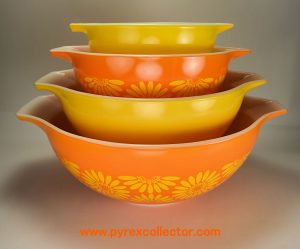
Patience is its own reward. This Daisy 440 set came from four separate purchases over a period of a year and a half, but all are VG to EX and ended up being right around $50 total.
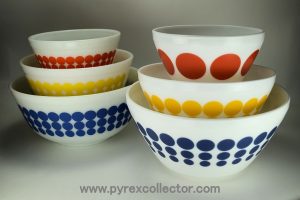
I picked up this set of Vintage Charm "Spot On" bowls at the Corningware outlet store in Foley, AL. In the hatbox packaging, they were $25, a price point I had said I thought more appropriate than $50 when I took part in a VC focus group at CMOG a couple of years ago. The group was composed entirely of vintage Pyrex collectors, so we were kind of a tough crowd. Most of us didn't care for the thinner, Corelle-like feel, and some of the patterns having a distracting overlapping seam. These Dots inspired bowls, however, have the same type of breaks as the original pattern. Other "Pyrex inspired" patterns in sleeve packaging were being offered there at as little as $15 - $20 per set.
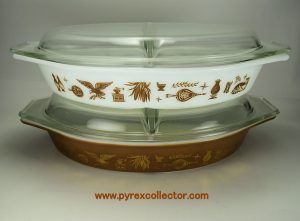
The more common gold on brown Early American 063 divided casserole is so common that the infrequently-seen brown on opal version really catches your eye when you encounter one.
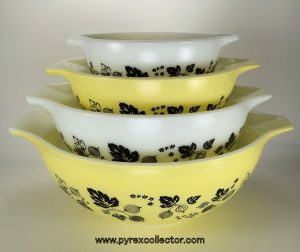
Gooseberry, 1957-1966. Black on yellow and opal limited to this 440 Cinderella bowl set.
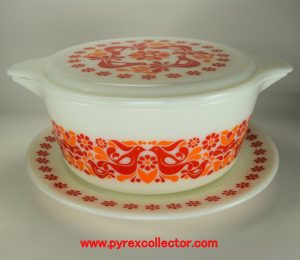
I hadn't planned on spending $100 on Pyrex when I went to lunch today, but I got a black & yellow Gooseberry Cinderella 440 set AND this Penn Dutch. Merry Christmas to me!
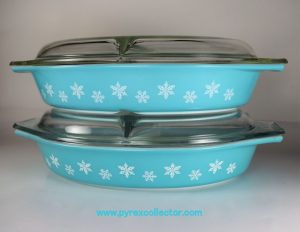
Two 063 oval divided casseroles. Can you spot the difference between them? The bottom one is older. This dish originally had no "crease" across the bottom, and was not marked with a model number. Neither was the 053 open baker, ostensibly allowing the same bottom mold half to be used for both. Other than saving a small amount of glass, the addition of the indentation appears to serve no practical purpose.
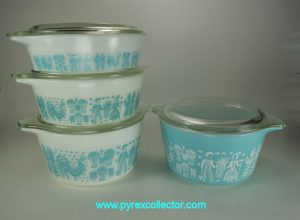
Butterprint (1957-1968) Cinderella round casseroles. The all turquoise on opal 470 set at left was a limited offering, as was an all pink on opal 470 set. Normally, the 471, 473, and 475 are white on turquoise like the dish at right. Limited run, promotional, and stamp program set patterns were often printed on plain, unpainted opal, ostensibly a production cost saving measure. Ironically, those like the pink Butterprint 470 set and the orange Butterprint 440 set are among the most coveted by collectors, and typically the most expensive to acquire.